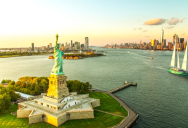The World’s Largest Wind Powered Cargo Ship Arrives In New York And Signals The Decarbonising Of The Shipping Industry

In our fight against the climate crisis, one of many big hurdles is shipping.
While cargo ships produce significantly less carbon emissions than air freight, they do emit 10-40 grams of CO₂ per kilometer.
Though it is seen as a more environmentally friendly alternative, those emissions stack up, with approximately 940 million tonnes of CO₂ emitted by the shipping industry every year.
That is over 2.5% of the world’s total annual carbon dioxide emissions.
And it’s not just that: cargo ships also emit huge amounts of sulfur oxide, methane, and nitrous oxide, thanks to their harmful engines that run on the combustions of heavy fuel oil.
It’s clear that the shipping industry needs to change.
Playing a part in leading this change is TOWT (Transport Á La Voile), whose wind-powered cargo ships are revolutionising the transportation of goods across the seas.

Recently, their largest wind-powered cargo ship, ‘Anemos’ arrived in the US after a 15 day voyage from France to New York.
With an average speed of 10 knots, the ship sailed complete with a haul of 1,000 tonnes of luxury French goods.
In a statement, TOWT explained more about the features and specifications of Anemos:
“Anemos, a highly technological vessel measuring 81 meter long and 13 meter high, is the first sistership in a fleet of 8 ships. It can transport over 1100 tons of cargo using wind power, reducing emissions by more than 90% compared to a conventional container ship.”
The goods on board were a testament to the trust in this cargo ship, with products amongst the 900 pallets including wine and champagne, luxury jams and swimwear.
Though many of the brands with goods on board preferred to keep their names confidential, some of the high-end companies whose names were revealed were Martell Mumm Perrier-Jouët, Château La Coste, Maison Joseph Drouhin, Andros, Chartreuse and Vilebrequin.

This was not the end of the journey for Anemos, though.
After unloading the cargo in New York, the ship set sail for Colombia to collect coffee from BELCO, which would then recreate the transatlantic crossing as she transported the goods to her home port in France.
Bon voyage, Anemos!
If you think that’s impressive, check out this story about a “goldmine” of lithium that was found in the U.S. that could completely change the EV battery game.

Sign up to get our BEST stories of the week straight to your inbox.




